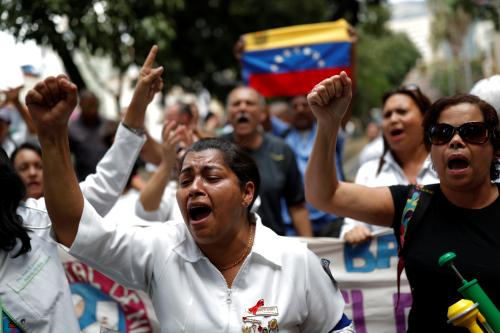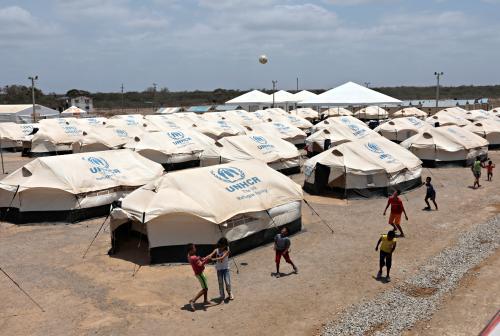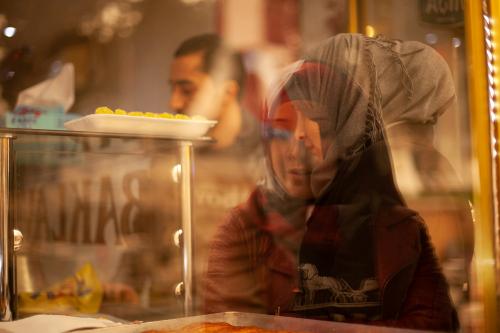The Venezuelan refugee crisis is just about to surpass the scale of the Syrian crisis.
As 2019 comes to a close, four years since the start of the Venezuelan humanitarian crisis, 4.6 million Venezuelans have fled the country, about 16 percent of the population. The figure is strikingly similar to the 4.8 million people that had fled Syria by 2015, four years into the massive forced displacement crisis there. As Figure 1 shows, the Venezuelan refugee crisis is one of the largest in modern history, and, if current trends continue, there could be as many as 6.5 million Venezuelans living outside of the country by 2020 (based on estimates from the U.N. Refugee Agency, UNHCR)—far outpacing the speed of displacement seen in Syria. In prior work, we show that the numbers could be significantly higher if the humanitarian crisis in Venezuela continues to worsen, reaching over 8 million.
Unlike other refugee crises, the Venezuelan one is not the result of conventional war or conflict. But the conditions Venezuelans face daily are not much different than those in an active war zone. Since 2013 the Venezuelan economy has contracted by 65 percent, the largest contraction outside of war in 45 years. The only close comparators are countries in active conflict, such as Liberia, which lost 90 percent of its GDP during its bloody civil war. But the Venezuelan economic collapse, which preceded international sanctions, stands out because it was not triggered by external forces or internal unrest: It was manufactured by those in power, and thus, was totally avoidable.
This has resulted in one of the worst humanitarian crises this hemisphere has ever seen. The U.N. Food and Agriculture Organization estimates that the undernourishment rate has quadrupled since 2012, and the U.N. estimates that 300,000 people’s lives are at risk due to limited access to medical treatment and lifesaving medications. In fact, Venezuela is quickly becoming a failed state, if it hasn’t become one already. Extended shortages of water and electricity have become the norm, and generalized violence—often carried out with the complicity of government security forces—makes the country one of the most violent in the world.
Thus, those fleeing Venezuela are refugees and should be entitled to the protections that come with that status. So far, the bulk of the hosting responsibilities, and hence integration challenges, have fallen on regional neighbors. Yet, despite the massive scale of displacement and humanitarian need, host nations—the three largest being Colombia, Ecuador, and Peru—have received very little support from the international community compared with other historical displacement episodes. In response to the Syrian crisis, for example, the international community mobilized large capital inflows, spending a cumulative $7.4 billion on refugee response efforts in the first four years. Funding for the Venezuelan crisis has not kept pace; four years into the crisis, the international community has spent just $580 million. On a per capita basis, this translates into $1,500 per Syrian refugee and $125 per Venezuelan refugee.
In November 2019, UNHCR and the International Organization for Migration (IOM) put out a $1.35 billion regional appeal for the Venezuelan refugee response in 2020. The appeal includes funds for humanitarian relief as well as for long-term social and economic inclusion efforts. This is a positive step toward a unified regional approach that provides for host communities as well as refugees. However, even if fully funded (the 2019 appeal, for instance, remains only 52 percent funded), the new appeal would only bring cumulative funding to $2 billion after five years of conflict. The Rohingya refugee crisis, on the other hand, reached this level of funding within two years, to assist 1.2 million displaced people—about a quarter of the Venezuelan refugee population. Even the South Sudan refugee crisis, also chronically underfunded, had received double Venezuela’s funding four years into the crisis.
Funding is crucial not only for the provision of short-term humanitarian needs, but also for investments in host communities, which promote successful refugee integration efforts. International financing can help bolster local infrastructure (hospital, schools, roads, electricity) and expand access to credit for local firms, both of which can help offset possible short-term negative labor market effects caused by the sudden labor supply inflow. In the case of Latin America, where infrastructure is already lagging behind, these investments are particularly important. Recognizing this crucial need, the Colombian government—the largest Venezuelan hosting nation—launched over $230 million in credit lines for infrastructure and private investment in areas with high refugee density, a policy that has not received the attention it deserves. In the same vein, the World Bank and the Inter-American Development Bank have opened up financing to Venezuelan host governments to help support the additional strain on public works. Yet given the scale of displacement, much more funding will be required.
What can we expect in 2020?
Unfortunately, there is no reason to believe that the massive Venezuelan displacement flows will abate anytime soon, so long as Maduro continues to hold power and the humanitarian situation continues to deteriorate.
The international community has largely been able to ignore this escalating catastrophe by labeling it as a regional crisis, not yet one of global scope. Yet the failure of the international community to mobilize additional funding to support host nation integration efforts may soon backfire: Some countries in the region, such as Ecuador, Peru, and Chile, have already imposed barriers to entry for Venezuelans, which could cause the refugee crisis to spill over to other regions. What’s more, with growing economic instability and social unrest in much of Latin America, Venezuelan migrants and refugees run the risk of being used as a scapegoat, further adding to xenophobic sentiments that continue to arise in the region.
There are no simple solutions—the crisis is politically complex, protracted, and involves over 17 regional host nations. Yet a key first step must be greater coordination between host nations and donors. While host countries, alongside UNHCR and IOM, have put together a platform for regional coordination (the Quito Process), countries have yet to agree on a comprehensive response plan, both in terms of policies and joint fundraising efforts. Key areas for policy collaboration include improved border management, a unified cross-border identification system, voluntary regional reallocation schemes, and joint infrastructure investments. Venezuelan President Juan Guaido and his interim government must join—and perhaps even lead—regional efforts to search for diplomatic solutions to the Venezuelan refugee crisis, working with the nearly 60 countries that recognize him as the legitimate President of the country—most of which are donor countries.
The Venezuelan refugee crisis has already reached a global scale. It now requires a global response.
The Brookings Institution is committed to quality, independence, and impact.
We are supported by a diverse array of funders. In line with our values and policies, each Brookings publication represents the sole views of its author(s).










Commentary
Venezuela refugee crisis to become the largest and most underfunded in modern history
December 9, 2019